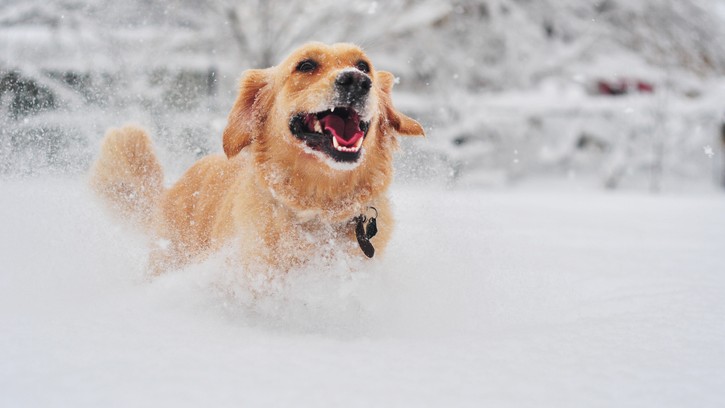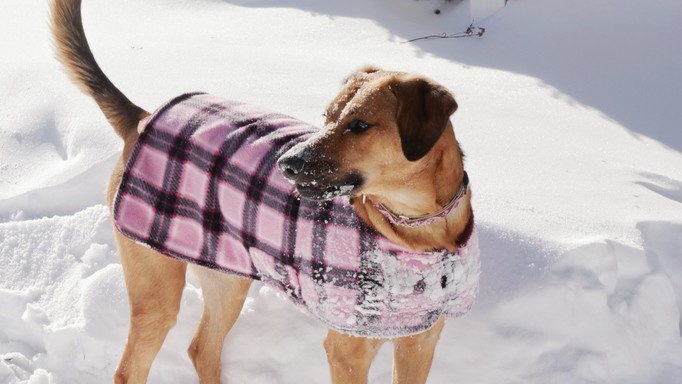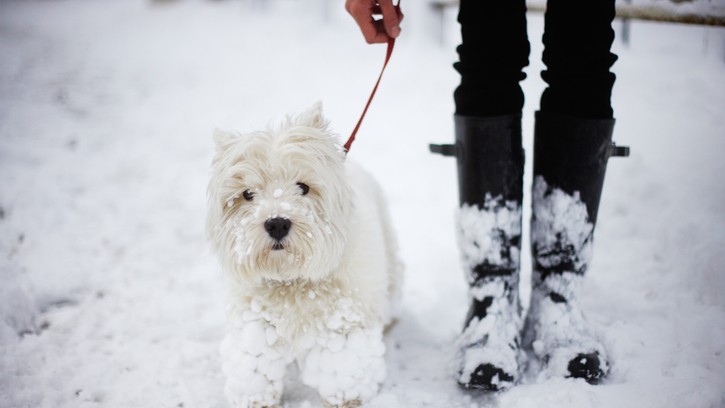Winter dog walking tips: making walkies a joy in the colder months
These winter dog walking tips will help protect your dog and keep them safe

As the nights draw in and the days start to get colder, you might be feeling unsure about how best to protect your furkid against the elements, but don’t worry because our winter dog walking tips are here to help. Everything you need to know about how to enjoy Jack Frost's season safely is right here so, by the time you’re through reading this piece, you’ll have the peace of mind you need to be able to relax and have fun in the great outdoors this winter with your favorite canine companion.
- Top tips for walking your dogs in the snow
- Best dog toys: Six options to keep your pet pooch amused
- Best dog bed: Give your pooch the perfect night’s sleep
- Best dog shampoo: Six brands to keep your pooch's fur and skin healthy, happy, and smelling great
Just like us, the safeguards you need to take over the colder months will vary depending on the conditions and the specific needs of your dog. Many dogs will do fine in cold, dry weather as long as you’re walking at a moderate pace and not undertaking a marathon. Bear in mind, though, that dogs can’t walk for longer than 15 minutes without boots if the ground is very cold or icy as aside from being painful, it can damage their paws. Temperatures under 10 degrees Fahrenheit will cause your pooch to get cold quickly, so consider investing in one of the best dog coats if you’ll be doing a lot of walking in sub-zero weather.
When it comes to freezing cold wind and rain, that’s another matter entirely as a wet dog is more susceptible to danger than a dry dog. The combination of rain and cold temperatures can cause your dog’s body temperature to lower much more quickly, increasing the risk of hypothermia. Also, while sporting a coat is great in both dry and wet weather, it won’t protect your dog against frostbite, which tends to show up on the paws, tail, and ears. As with all things, common sense is the best approach – if it’s very wet, consider exercising indoors or, if it’s dry but the temperatures have really plummeted, wrap your dog up well and stick to a short walk.
Okay, are you ready for more winter dog walking tips? Well, stick around because we’ve got plenty more of them that are going to help you and your dog stay safe while having fun this winter. Let’s dive in!
Inspect feet regularly in winter
Have you ever experienced painfully dry lips or cracked skin when you’ve been outside in cold weather? Just like us, the cold can do some damage to your dog on the part of their body that has the most direct contact with it – their paws.
Check their feet regularly over the colder months, inspecting both the nails and the pads. A dog’s toenails are at greater risk of being damaged when they’re walking on frozen ground or ice, so invest in a good pair of the best dog nail clippers so that you can keep their nails trimmed short.
Consider clipping the hair between the paw pads as well as their nails, as snow and ice can often get stuck there, causing discomfort and even frostbite. Less hair in that area means less chance of this happening. Also, inspect the pads for cracks or inflammation. To reduce the risk of these painful conditions, think about applying a paw balm or purchasing a pair of dog boots.
Get the best advice, tips and top tech for your beloved Pets
Consider the needs of your dog
Just like humans, dogs come in all shapes and sizes, so it’s important to consider the unique needs of your fur baby. Short-Haired dogs, small dogs, and leaner breeds who don’t carry a lot of body fat won’t be able to brave the elements for as long as more robust breeds.
Age is also a factor to consider, with very young and very old dogs being unable to tolerate the cold for long periods. Geriatric or arthritic dogs require close monitoring as the cold can exacerbate the pain in aging joints and make it harder for them to move around.
Health status and lifestyle can also affect tolerance to cold. Dogs with immune or metabolic disorders, hypothyroidism, or Cushing's disease, may display worsening symptoms when exposed to freezing temperatures. Those who consider sleeping their chosen sport and are not particularly active may also find the cold affects them quicker than athletic breeds.
Dress for the elements
Keep your pooch looking stylish and feeling warm this winter with the perfect dog coat to keep them snug and dry.
While your dog’s hair type can be a useful starting point when considering whether or not they need a coat, there’s an even easier test to take the guesswork out of it. If you open the door to take them walking and they start shivering or trying to get back into the house, then they need a coat.
If you’re wearing a sweater, then that’ll likely be good enough for them too, and if you’re rugged up in thermals and several layers of wind and rainproof gear, then opt for a thick, doggy jacket. Remember to check that they’re not too hot if the sun comes out.

Remain visible
While we’re on the topic of clothing, both you and your dog must remain visible. Consider purchasing them a jacket that has fluorescent strips on it, or buy these separately and affix them yourself.
You might also want to think about getting a lead that lights up or a collar that flashes so that you and your dog can be seen when walking in the dark. Carrying a flashlight can also be helpful, not just in the early mornings or evenings when it’s dark, but when visibility is low due to fog or snow.
Avoid the coldest parts of the day
Try not to take your dog walking early in the morning or late at night when the temperatures will be at their coldest. Instead, opt to give your dog the biggest part of their daily exercise during the hours of 11am and 2pm, when the weather will be warmer.

Brand your dog
Now, before you panic, please rest assured that we’re not suggesting you whip out the cattle branding iron, the kind of branding we’re talking about is painless, we promise!
Make sure your dog is wearing an engraved tag on their collar and consider also having them microchipped, read our article seven reasons to get your dog microchipped for more info. If you let your fur baby off their lead and they run off when visibility is poor, whoever finds them can quickly identify who they belong to and return them to you safely.
Keep them on a lead if it's snowing
Many dogs love the snow, and the excitement can be all too much. The last thing you want is to have them darting off all over the place, especially if the area you’re walking them in is close to a busy road.
Snow drifts can also hide hazards, such as frozen bodies of water, that may not be able to support your dog’s weight. Keep your dog on their lead and stick plowed sidewalks wherever possible to eliminate the risk of your fur baby getting hurt.
Watch what they eat
While it may sound silly that you’d have to be concerned about your dog sipping on antifreeze, this sweet-smelling toxin that attracts dogs can sometimes leak out of cars or be spilled on sidewalks where your dog walks through it and then licks their paws. Make sure you thoroughly wash your dog's paws when you get home or have them wear boots when outside.
Also, while seemingly harmless, don’t let your dog ingest any snow as this can dangerously lower their body temperature and lead to hypothermia.

Take the fun indoors
We know this is an article about winter dog walking tips, but if your pawsome pal just can’t muster the enthusiasm to head outside to have some fun, why not bring the fun to them?
While you don’t want to avoid the outdoors altogether, there’s plenty of warm indoor fun to be had. Hide toys and encourage your dog to find them by rewarding them with a treat, play fetch (in a space with no precious breakables that is!), or set up an agility course if you have the room with cones and a few objects that they can climb over or walk around.
You could even try taking your dog to an indoor hydrotherapy pool and give them a water-based workout. Or why not set up a doggy play date with their favorite bestie? You can even give them a mental workout with some food enrichment fun. Let your imagination go wild, and the indoor opportunities are endless.
Stay safe and have fun this winter
So there you have it, some super simple tips that can help you protect your precious pooch over the colder months. With a little preparation and an awareness of some of the potential hazards that the chilly weather can bring, you can keep your dog happy, warm, and safe this winter.

Kathryn is a freelance writer who has been a member of the PetsRadar family since it launched in 2020. Highly experienced in her field, she's driven by a desire to provide pet parents with accurate, timely, and informative content that enables them to provide their fur friends with everything they need to thrive.
Kathryn works closely with vets and trainers to ensure all articles offer the most up-to-date information across a range of pet-related fields, from insights into health and behavior issues to tips on products and training.
When she’s not busy crafting the perfect sentence for her features, buying guides and news pieces, she can be found hanging out with her family (which includes one super sassy cat and a kitten), drinking copious amounts of Jasmine tea and reading all the books.
She has written for a range of publications, including Fit&Well, Top Ten Reviews, LiveScience, Goodto, and Product Hunt.
